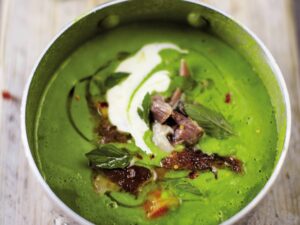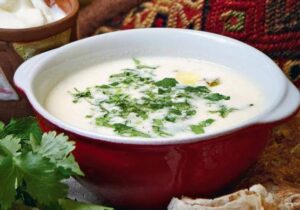About Afganistani shorba:-

Afghan Shorba is a traditional soup from Afghanistan that is both hearty and flavorful, typically made with meat (often lamb or chicken), vegetables, and aromatic spices. It’s a staple in Afghan cuisine and reflects the country’s culinary traditions, which are influenced by the diverse cultures that have passed through the region over the centuries, including Persian, Indian, and Central Asian.
Key Characteristics of Afghan Shorba:

- Meat-Based:
- Shorba often features lamb or chicken as the main protein. The meat is usually cooked on the bone, which adds richness and depth to the broth.
- Simple Ingredients:
- The soup is made with readily available ingredients like onions, tomatoes, carrots, potatoes, and chickpeas. The simplicity of these ingredients allows the natural flavors of the meat and vegetables to shine.
- Aromatic Spices:
- Afghan Shorba is seasoned with a variety of spices that are common in Afghan cooking, such as cumin, coriander, turmeric, black pepper, and cinnamon. These spices give the soup a warm, aromatic flavor profile.
- Broth-Based:
- The base of the soup is a broth, which can be made from water or stock. The broth is usually light but flavorful, and it becomes richer as it simmers with the meat and vegetables.
- Hearty and Nourishing:
- Afghan Shorba is known for being a filling and nourishing dish, making it perfect for cold weather or as a satisfying main course. It is often served with naan or other types of bread, which can be dipped into the broth.
- Versatile:
- While the basic components of shorba are consistent, variations exist depending on the region and available ingredients. Some versions might include lentils, different types of meat, or additional vegetables.
- Cultural Significance:
- In Afghanistan, shorba is often served during family gatherings, special occasions, and as part of traditional meals. It embodies the warmth and hospitality of Afghan culture.
Popular Variations:
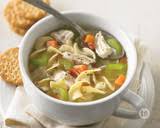
- Lamb Shorba: The most common version, made with lamb, which is popular in Afghan cuisine. The lamb is slow-cooked to ensure tenderness and flavor.
- Chicken Shorba: A lighter version of the soup, made with chicken. It’s often served with rice or bread.
- Vegetable Shorba: A meatless version that focuses on vegetables and legumes, making it suitable for vegetarians.
Serving Afghan Shorba:
- Afghan Shorba is typically served hot, often garnished with fresh herbs like cilantro or parsley. A wedge of lemon or lime may be provided on the side to squeeze over the soup, adding a bright, tangy contrast to the rich flavors.
Read this also;- Tomato soup , chicken soup Buttermilk recipe:-
Afghanistani Shorba soups are beloved for several reasons, each contributing to their widespreadapso appeal and comfort:
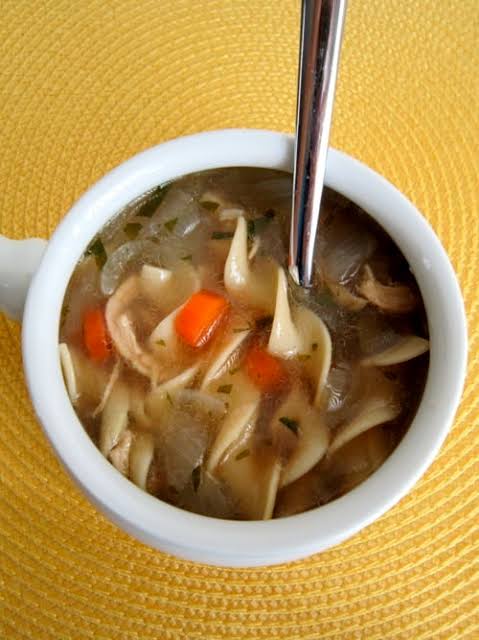
1. Rich Flavors:
- The combination of tender meat, fresh vegetables, and a medley of spices creates a deeply flavorful broth. The slow-cooked nature of Shorba allows the flavors to meld together, resulting in a satisfying and aromatic dish.
2. Comforting and Nourishing:
- Shorba is often associated with warmth and comfort, making it a perfect meal for cold days or when you need something nourishing. The hearty broth, filled with meat and vegetables, provides a sense of well-being and satisfaction.
3. Cultural Tradition:
- For many, Shorba carries a sense of nostalgia and connection to Afghan culture and family traditions. It’s a dish that is often passed down through generations, symbolizing family, love, and the warmth of home.
4. Versatility:
- Shorba can be adapted to suit different tastes and dietary needs. Whether you prefer lamb, chicken, or a vegetarian version, there’s a Shorba recipe that can be tailored to your liking. Its simplicity allows for flexibility in ingredients without losing its essence.
5. Health Benefits:
- The ingredients in Shorba are often wholesome and nutritious. Lean meats, vegetables, and legumes provide essential nutrients, while the spices used, such as turmeric and cumin, have known health benefits, including anti-inflammatory properties.
6. Culinary Balance:
- The balance of spices and ingredients in Shorba creates a dish that is neither too spicy nor too mild, appealing to a wide range of palates. The subtle use of spices enhances the natural flavors of the meat and vegetables without overpowering them.
7. Simplicity and Ease:
- Despite its complex flavors, Shorba is relatively simple to make, requiring basic ingredients and straightforward cooking techniques. This makes it accessible for home cooks and allows the focus to remain on the quality of the ingredients and the care put into cooking.
8. Social and Communal Aspect:
- Shorba is often enjoyed in a communal setting, shared among family and friends. The act of sharing a warm, hearty soup fosters a sense of community and togetherness, enhancing the overall experience.
9. Connection to Tradition and Heritage:
- For those with Afghan roots or an appreciation for Afghan culture, Shorba is more than just a meal—it’s a connection to heritage and tradition. Enjoying Shorba can evoke memories of family gatherings, cultural celebrations, and the preservation of culinary customs.
10. Universally Appealing:
The universal appeal of Shorba lies in its simplicity and the comfort it provides. Even those unfamiliar with Afghan cuisine can appreciate the warmth and nourishment that a well-made bowl of Shorba offers.
variation of afganistani shorba soup:
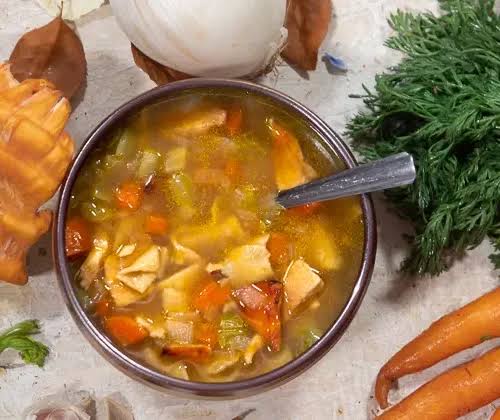
Afghanistani Shorba soups come in various forms, each reflecting the diversity of Afghan cuisine and the adaptability of this traditional dish. Here are some popular variations:
1. Lamb Shorba
- Ingredients: Lamb (often on the bone), onions, tomatoes, carrots, potatoes, garlic, cumin, coriander, turmeric, cinnamon, and bay leaves.
- Characteristics: The most traditional and popular version, featuring lamb as the main protein. The lamb is slow-cooked with spices and vegetables, creating a rich and hearty broth.
2. Chicken Shorba
- Ingredients: Chicken (often bone-in), onions, tomatoes, carrots, potatoes, garlic, cumin, coriander, turmeric, black pepper, and cilantro.
- Characteristics: A lighter variation made with chicken, this version is often quicker to prepare than lamb Shorba. The chicken is simmered until tender, and the broth is flavorful yet not as heavy as the lamb version.
3. Vegetable Shorba
- Ingredients: Mixed vegetables (such as carrots, potatoes, peas, tomatoes), onions, garlic, cumin, coriander, turmeric, and vegetable broth.
- Characteristics: A vegetarian version that focuses on the natural flavors of fresh vegetables. This variation is light, healthy, and ideal for those who prefer a meatless option.
4. Mung Bean Shorba (Mashawa)
- Ingredients: Mung beans, meat (lamb or beef, optional), onions, garlic, tomatoes, cumin, coriander, and turmeric.
- Characteristics: This variation features mung beans as the primary ingredient, often combined with meat. It’s a protein-packed soup that is both hearty and nutritious.
5. Lentil Shorba
- Ingredients: Lentils (red or yellow), onions, garlic, tomatoes, cumin, coriander, turmeric, and fresh herbs like cilantro.
- Characteristics: A popular choice in Afghan households, lentil Shorba is both hearty and healthy. It’s a great source of plant-based protein and is often enjoyed with a squeeze of lemon for added freshness.
6. Aash (Noodle Shorba)
- Ingredients: Noodles (often homemade), chickpeas, lentils, ground meat (optional), onions, garlic, spinach, turmeric, and fresh herbs.
- Characteristics: Aash is a thicker, noodle-based variation of Shorba. It’s more like a stew and is rich and filling. The addition of yogurt and dried mint on top adds a unique flavor profile.
7. Yakhni Shorba
- Ingredients: Bone-in meat (lamb or chicken), onions, garlic, whole spices (cumin seeds, cinnamon, cloves, cardamom), ginger, and turmeric.
- Characteristics: Yakhni Shorba is a clear broth soup, often made by simmering meat bones with spices for an extended period. It’s known for its restorative properties and is often consumed when someone is unwell.
8. Pacha (Head and Trotter Soup)
- Ingredients: Lamb or cow’s head and trotters, garlic, onions, turmeric, and black pepper.
- Characteristics: A traditional dish often prepared for special occasions, Pacha is made by slow-cooking the head and trotters of lamb or cow. The resulting soup is rich in gelatin and nutrients, with a unique, robust flavor.
9. Kofta Shorba
- Ingredients: Meatballs (kofta) made from minced meat (lamb or beef), onions, tomatoes, garlic, cumin, coriander, and turmeric.
- Characteristics: This variation features spiced meatballs simmered in a flavorful broth. It’s a comforting dish that combines the heartiness of Shorba with the richness of kofta.
10. Dal Shorba
- Ingredients: Yellow split peas (chana dal), onions, garlic, tomatoes, cumin, coriander, turmeric, and cilantro.
- Characteristics: A simple yet satisfying soup made with split peas, dal Shorba is rich in protein and fiber. It’s a staple in many Afghan households, often served with bread or rice.
11. Aushak Shorba
- Ingredients: Aushak (Afghan dumplings filled with leeks or chives), yogurt, garlic, ground meat, and tomato sauce.
- Characteristics: Aushak is usually served as a dish with tomato-based meat sauce and yogurt, but it can also be served in a Shorba-style broth. The dumplings soak up the flavors of the soup, making it a unique and flavorful variation.
optional ingadients for making afganistani shorba soups recipe:-
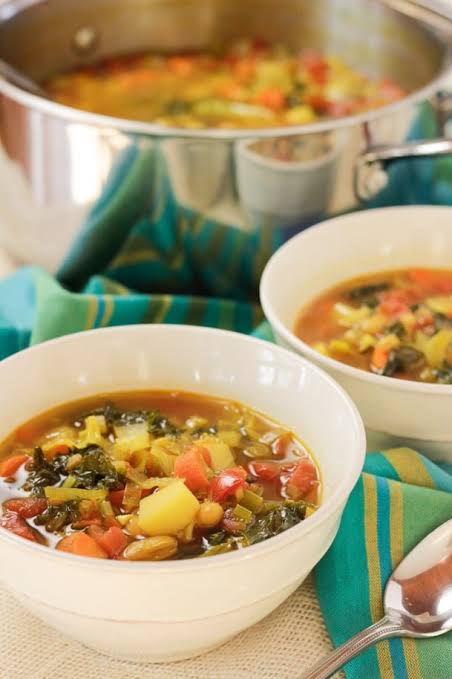
When making Afghanistani Shorba soups, there are several optional ingredients you can use to enhance or modify the flavor, texture, and nutritional content of the soup. Here are some suggestions:
1. Chickpeas or Other Legumes
- Use: Chickpeas, lentils, or mung beans can be added for extra protein and texture.
- Effect: They make the soup heartier and more filling, adding a slight nutty flavor.
2. Rice or Barley
- Use: A small amount of rice or barley can be added to the soup.
- Effect: These grains can help thicken the broth and make the soup more substantial.
3. Tomato Paste or Puree
- Use: Tomato paste or puree can be added to deepen the flavor and give the soup a richer color.
- Effect: It adds a tangy, slightly sweet flavor, enhancing the soup’s depth.
4. Yogurt
- Use: A dollop of plain yogurt can be added before serving.
- Effect: Yogurt adds creaminess and a slight tang, balancing the spices and adding a cooling element.
5. Fresh Herbs
- Use: Fresh cilantro, parsley, mint, or dill can be sprinkled on top before serving.
- Effect: Fresh herbs add brightness and a fresh, aromatic flavor.
6. Lemon or Lime Juice
- Use: Squeeze fresh lemon or lime juice into the soup before serving.
- Effect: The citrus adds a zesty, tangy contrast to the rich flavors, brightening up the dish.
7. Spices
- Use: Additional spices like garam masala, paprika, saffron, or cardamom can be included.
- Effect: They introduce new layers of flavor, making the soup more aromatic and complex.
8. Garlic and Ginger
- Use: Extra garlic or fresh ginger can be added for more robust flavors.
- Effect: Garlic and ginger add warmth and depth, enhancing the overall taste of the soup.
9. Chili Peppers or Chili Powder
- Use: Fresh or dried chili peppers, or a pinch of chili powder, can be added for heat.
- Effect: Adds a spicy kick to the soup, making it more vibrant and warming.
10. Spinach or Other Leafy Greens
- Use: Fresh spinach, kale, or chard can be stirred in towards the end of cooking.
- Effect: Adds color, nutrition, and a slightly earthy flavor to the soup.
11. Noodles or Dumplings
- Use: Thin noodles or small dumplings like aushak can be added to the soup.
- Effect: These additions make the soup more filling and give it a different texture.
12. Butter or Ghee
- Use: A small amount of butter or ghee can be added for richness.
- Effect: Adds a buttery, luxurious mouthfeel to the broth, enhancing the overall flavor.
13. Coconut Milk
- Use: Coconut milk can be added for a creamy, slightly sweet twist.
- Effect: Introduces a subtle sweetness and creaminess, creating a unique flavor profile.
14. Fenugreek Leaves (Methi)
- Use: Dried or fresh fenugreek leaves can be added towards the end of cooking.
- Effect: Adds a slightly bitter, aromatic flavor that complements the other spices.
15. Saffron
- Use: A pinch of saffron threads can be steeped in hot water and added to the soup.
- Effect: Saffron adds a golden color and a subtle, luxurious flavor.
Recipe Ingradients:-
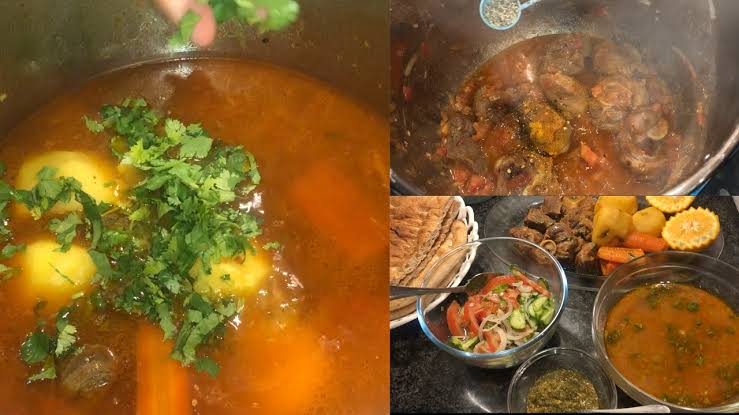
Ingredients:
- Lamb with bones: 500 grams
- Onions: 150 grams (finely chopped)
- Garlic: 10 grams (about 2-3 cloves, minced)
- Tomatoes: 200 grams (chopped)
- Carrots: 150 grams (sliced)
- Potatoes: 200 grams (cubed)
- Chickpeas (cooked or canned): 150 grams
- Vegetable oil: 30 grams (about 2-3 tablespoons)
- Ground cumin: 5 grams (about 1 teaspoon)
- Ground coriander: 5 grams (about 1 teaspoon)
- Turmeric: 2.5 grams (about 1/2 teaspoon)
- Ground black pepper: 2.5 grams (about 1/2 teaspoon)
- Ground cinnamon: 2.5 grams (about 1/2 teaspoon)
- Bay leaves: 1-2 leaves
- Salt: 10 grams (about 1-2 teaspoons, adjust to taste)
- Water or broth: 1.5 liters
- Fresh cilantro or parsley: 10-15 grams (for garnish)
- Lemon wedges: 1 lemon, cut into wedges (optional, for serving)
Process of making:-
Heat the Oil:
- In a large pot, heat 30 grams of vegetable oil over medium heat.
Brown the Lamb:
- Add 500 grams of lamb pieces to the pot and brown them on all sides. Once browned, remove the lamb from the pot and set it aside.
Sauté the Onions and Garlic:
- In the same pot, add 150 grams of chopped onions. Sauté until they turn golden brown, then add 10 grams of minced garlic and cook for another minute.
Add the Spices:
- Stir in 5 grams of ground cumin, 5 grams of ground coriander, 2.5 grams of turmeric, 2.5 grams of ground black pepper, 2.5 grams of ground cinnamon, and 1-2 bay leaves. Cook the spices with the onions and garlic for a couple of minutes until aromatic.
Add the Tomatoes:
- Add 200 grams of chopped tomatoes to the pot and cook until they soften and blend with the spices.
Return the Lamb:
- Add the browned lamb back into the pot and stir to coat the lamb with the spice mixture.
Add Water/Broth:
- Pour in 1.5 liters of water or broth, enough to cover the lamb and vegetables. Bring the mixture to a boil.
Simmer:
- Reduce the heat to low, cover the pot, and let the soup simmer for about 1.5 to 2 hours, or until the lamb is tender and the flavors have melded together.
Add Vegetables:
- After about an hour of simmering, add 150 grams of sliced carrots, 200 grams of cubed potatoes, and 150 grams of cooked chickpeas to the pot. Continue to simmer until the vegetables are tender, about 30-40 minutes.
Adjust Seasoning:
- Taste the soup and add about 10 grams of salt, adjusting to your preference.
Serve:
- Ladle the shorba into bowls, garnish with 10-15 grams of fresh cilantro or parsley, and serve with lemon wedges on the side.
Advantage of eating Afganistani shorba soup:-
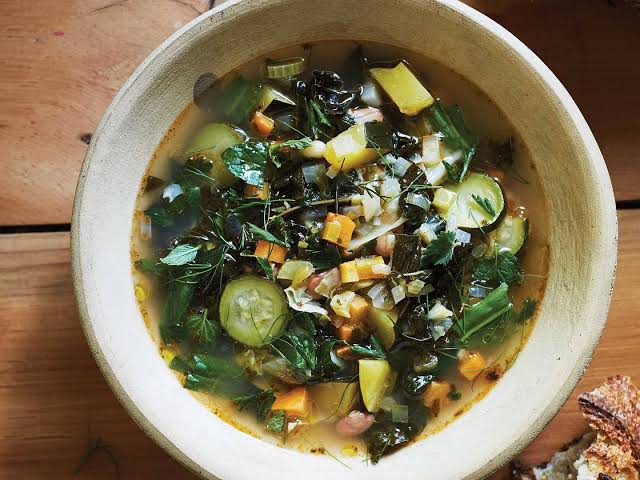
Afghan Lamb Shorba is not only a delicious and comforting dish but also offers several health benefits. Here are some of the advantages of eating Afghan Lamb Shorba:
1. Rich in Protein:
- Benefit: Lamb is an excellent source of high-quality protein, which is essential for building and repairing tissues, supporting immune function, and maintaining muscle mass. The protein in lamb also helps keep you feeling full and satisfied.
2. Nutrient-Dense:
- Benefit: Lamb is rich in essential nutrients such as iron, zinc, and vitamin B12. Iron is crucial for producing red blood cells and preventing anemia, while zinc supports immune function and wound healing. Vitamin B12 is important for brain health and energy production.
3. Bone Health:
- Benefit: Lamb Shorba often includes bone-in meat, which releases bone marrow and collagen into the soup during cooking. These components are beneficial for joint and bone health, providing important nutrients like calcium and gelatin.
4. Boosts Immune System:
- Benefit: The spices used in Afghan Shorba, such as turmeric, cumin, and coriander, have immune-boosting properties. Turmeric, in particular, contains curcumin, which has anti-inflammatory and antioxidant effects, helping to support overall health and fight off infections.
5. Supports Digestive Health:
- Benefit: The vegetables and spices in Shorba, like garlic and onions, contain fiber and prebiotics that support healthy digestion. Fiber helps to regulate bowel movements, while prebiotics promote the growth of beneficial gut bacteria.
6. Hydration and Electrolyte Balance:
- Benefit: Shorba is broth-based, making it an excellent source of hydration, especially in cold weather or when recovering from illness. The broth also contains electrolytes like sodium and potassium, which are essential for maintaining fluid balance in the body.
7. Promotes Satiety:
- Benefit: The combination of protein, fiber, and healthy fats in Shorba helps to promote feelings of fullness and reduce overeating. This can be beneficial for weight management and preventing unhealthy snacking.
8. Anti-Inflammatory Properties:
- Benefit: Many of the spices in Shorba, such as turmeric, garlic, and black pepper, have anti-inflammatory properties. Regular consumption of these ingredients may help reduce chronic inflammation, which is linked to various diseases, including heart disease and arthritis.
9. Provides Comfort and Warmth:
- Benefit: Shorba is a warm, comforting soup that is particularly beneficial during cold weather or when feeling unwell. It can help soothe the throat, warm the body, and provide a sense of comfort and well-being.
10. Balanced Nutrition:
- Benefit: Afghan Lamb Shorba provides a balanced mix of protein, healthy fats, and carbohydrates, along with essential vitamins and minerals. This makes it a well-rounded meal that can support overall health and wellness.
11. Helps in Recovery:
- Benefit: The nutrients and warmth of Shorba make it an ideal food for recovery from illness, surgery, or physical exertion. The broth is easy to digest and provides essential nutrients needed for recovery.
12. Cultural and Emotional Benefits:
- Benefit: For those with ties to Afghan culture or those who enjoy exploring global cuisines, eating Shorba can provide a sense of connection to tradition, family, and heritage. Sharing this meal with loved ones can also strengthen social bonds and create lasting memories.
While Afghan Lamb Shorba is a nutritious and comforting dish, there are some potential disadvantages to consider, particularly if consumed in excess or without attention to dietary needs. Here are some possible disadvantages:
1. High in Saturated Fat:
- Disadvantage: Lamb can be high in saturated fat, which may contribute to elevated cholesterol levels if consumed in large quantities. High saturated fat intake is associated with an increased risk of heart disease.
2. Calorie-Dense:
- Disadvantage: Depending on the amount of meat and added oil or ghee, Shorba can be calorie-dense. For individuals managing their calorie intake or trying to lose weight, this could be a concern.
3. Sodium Content:
- Disadvantage: If using store-bought broth or adding salt, the sodium content of the soup can be high. Excess sodium can contribute to high blood pressure and other cardiovascular issues.
4. Potential for Overconsumption of Red Meat:
- Disadvantage: Regular consumption of red meat, including lamb, can be associated with various health risks, such as an increased risk of certain cancers and cardiovascular disease. Moderation is key to balancing these risks.
5. Digestive Sensitivity:
- Disadvantage: The spices used in Shorba, such as black pepper and garlic, may cause digestive discomfort or exacerbate symptoms in individuals with sensitive stomachs or gastrointestinal conditions.
6. Allergies or Sensitivities:
- Disadvantage: Some people may have allergies or sensitivities to certain ingredients used in Shorba, such as spices or legumes. This could lead to allergic reactions or gastrointestinal issues.
7. Preparation Time:
- Disadvantage: Shorba requires a longer cooking time, especially if using bone-in meat. This might not be ideal for those looking for a quick meal option.
8. Potential for High Cholesterol:
- Disadvantage: The use of fatty cuts of lamb can contribute to high cholesterol levels. Individuals with high cholesterol or those at risk for heart disease should be mindful of their intake.
9. Limited Plant-Based Options:
- Disadvantage: Traditional Shorba recipes are meat-based, which might not align with vegetarian or vegan dietary preferences. While there are vegetable and lentil versions, they are less common.
10. Spice Sensitivity:
- Disadvantage: The spiciness of Shorba may not be suitable for everyone. People with certain health conditions or those sensitive to spicy foods may need to adjust the recipe to suit their tolerance.
11. Potential for Food Safety Concerns:
- Disadvantage: Proper handling and cooking of lamb are essential to avoid foodborne illnesses. Undercooked or improperly stored meat can pose health risks.
12. Cost:
Disadvantage: Lamb can be more expensive compared to other protein sources. This may make Shorba a less affordable option for those on a tight budget.
What is Afghan Lamb Shorba?
Answer: Afghan Lamb Shorba is a traditional Afghan soup made with lamb, vegetables, and a blend of spices. It is known for its rich, flavorful broth and hearty ingredients, making it a comforting and nutritious dish.
What are the key ingredients in Afghan Lamb Shorba?
Answer: Key ingredients typically include lamb (often with bones), onions, garlic, tomatoes, carrots, potatoes, chickpeas, and a variety of spices such as cumin, coriander, turmeric, and cinnamon.
Can I make Afghan Lamb Shorba with other types of meat?
Answer: Yes, you can substitute lamb with other meats such as beef or chicken. The cooking time and flavor profile may vary depending on the type of meat used.
